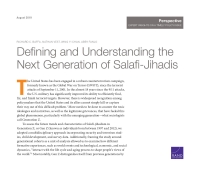PDF file 0.2 MB
 As the first members of Generation Z, or Gen Z (those born between 1997 and 2012), enter adulthood, how might Salafi-jihadism manifest differently in Gen Z than in previous generations? How will the political upheavals of the Middle East, socioeconomic trends throughout the Muslim world, and rising digital connectivity affect susceptibility to radicalization in Gen Z?
As the first members of Generation Z, or Gen Z (those born between 1997 and 2012), enter adulthood, how might Salafi-jihadism manifest differently in Gen Z than in previous generations? How will the political upheavals of the Middle East, socioeconomic trends throughout the Muslim world, and rising digital connectivity affect susceptibility to radicalization in Gen Z?
In this Perspective, the authors explore the unique characteristics and expected drivers of Salafi-jihadism in Gen Z, elucidate potential threats and challenges from the next generation of Salafi-jihadis, and put forward recommendations for counter violent extremism programming to address the future threat. A review of the literature suggests that many of the overarching factors that drove past generations of Salafi-jihadis will remain salient in the coming generational cohort, although the manifestations of these factors will vary across localities. However, Gen Z's unprecedented familiarity with and connection to the internet and modern technology differentiate these members from previous Salafi-jihadis and portend an adaptive, tech-savvy future terrorist threat.
No comments:
Post a Comment